Introduction:
Packaging your Node.js application ensures easy distribution, installation, and maintenance. In this tutorial, we’ll delve into the essential steps and best practices for packaging your Node.js application effectively.
1. Understanding Node.js Packaging:
Before diving into the packaging process, let’s understand what Node.js packaging entails. Node.js packages typically include your application’s code, dependencies, configuration files, and metadata necessary for installation and execution.
2. Setting Up Your Project:
Ensure your Node.js application follows the standard project structure. It should include entry points, such as package.json, where you define your project’s metadata and dependencies.
3. Defining Dependencies:
Use package.json to list your project dependencies. Specify both runtime and development dependencies accurately to ensure proper installation and execution.
4. Creating a Package.json File:
If your project doesn’t have a package.json file yet, create one using the npm init command. Follow the prompts to provide essential information about your project.
5. Managing Scripts:
Utilize the scripts field in package.json to define custom scripts for building, testing, and running your application. This simplifies common tasks and ensures consistency across environments.
6. Handling Dependencies:
To package your application along with its dependencies, you can use tools like npm or yarn. These tools bundle your application’s code and dependencies into a distributable format.
7. Optimizing Your Package Size:
Optimize your package size by excluding unnecessary files and dependencies. Utilize tools like npm prune or yarn autoclean to remove unused dependencies and files from your project.
8. Versioning Your Package:
Follow semantic versioning (SemVer) principles to version your package effectively. Update the version number in package.json with every release to maintain clarity and compatibility.
9. Publishing Your Package:
If you intend to share your package with others, consider publishing it to a package registry like npm or Yarn. Use the respective command-line tools (npm publish or yarn publish) to publish your package.
10. Installing Your Package:
Once published, others can install your package using npm or Yarn. They can add it as a dependency in their projects by running npm install <package-name> or yarn add <package-name>.
Conclusion:
Packaging your Node.js application is crucial for its distribution, installation, and maintenance. By following the steps outlined in this tutorial and adopting best practices, you can ensure your application is easily consumable by others in the Node.js ecosystem.


